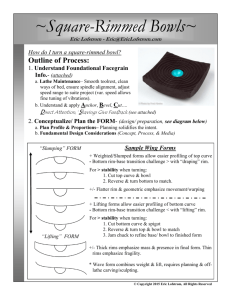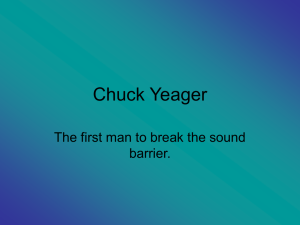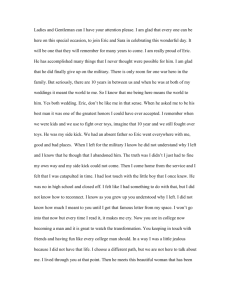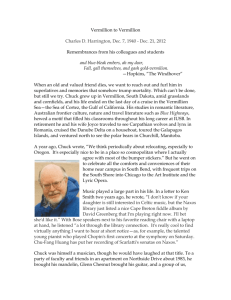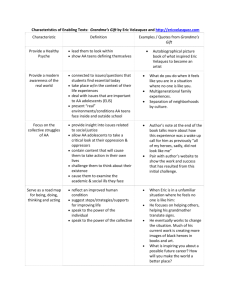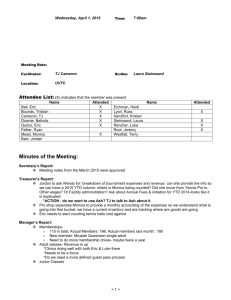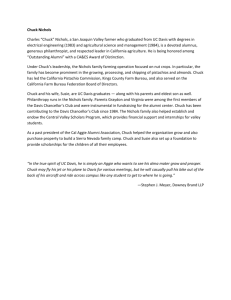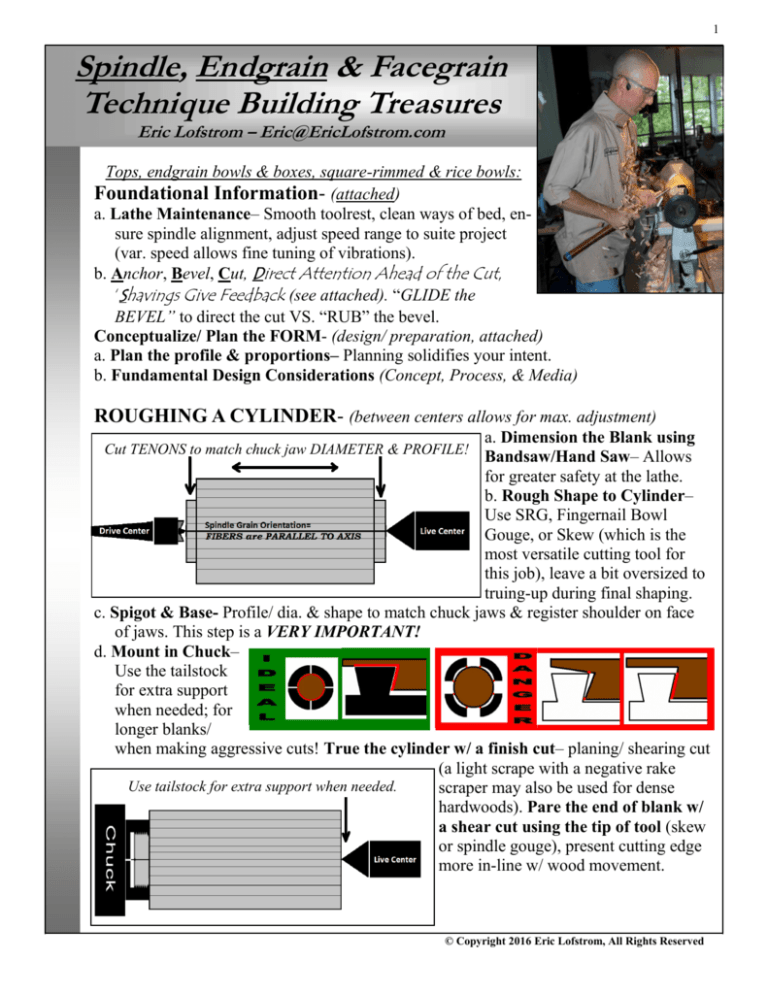
1
Spindle, Endgrain & Facegrain
Technique Building Treasures
Eric Lofstrom – Eric@EricLofstrom.com
Tops, endgrain bowls & boxes, square-rimmed & rice bowls:
Foundational Information- (attached)
a. Lathe Maintenance– Smooth toolrest, clean ways of bed, ensure spindle alignment, adjust speed range to suite project
(var. speed allows fine tuning of vibrations).
b. Anchor, Bevel, Cut, Direct Attention Ahead of the Cut,
‘Shavings Give Feedback (see attached). “GLIDE the
BEVEL” to direct the cut VS. “RUB” the bevel.
Conceptualize/ Plan the FORM- (design/ preparation, attached)
a. Plan the profile & proportions– Planning solidifies your intent.
b. Fundamental Design Considerations (Concept, Process, & Media)
ROUGHING A CYLINDER- (between centers allows for max. adjustment)
a. Dimension the Blank using
Bandsaw/Hand Saw– Allows
for greater safety at the lathe.
b. Rough Shape to Cylinder–
Use SRG, Fingernail Bowl
Gouge, or Skew (which is the
most versatile cutting tool for
this job), leave a bit oversized to
truing-up during final shaping.
c. Spigot & Base- Profile/ dia. & shape to match chuck jaws & register shoulder on face
of jaws. This step is a VERY IMPORTANT!
d. Mount in Chuck–
Use the tailstock
for extra support
when needed; for
longer blanks/
when making aggressive cuts! True the cylinder w/ a finish cut– planing/ shearing cut
(a light scrape with a negative rake
Use tailstock for extra support when needed.
scraper may also be used for dense
hardwoods). Pare the end of blank w/
a shear cut using the tip of tool (skew
or spindle gouge), present cutting edge
more in-line w/ wood movement.
Cut TENONS to match chuck jaw DIAMETER & PROFILE!
© Copyright 2016 Eric Lofstrom, All Rights Reserved
2
Spindle, Endgrain & Facegrain
Technique Building Treasures
Eric Lofstrom – Eric@EricLofstrom.com
SPINNING TOPS- (chuck mounted) Aim for the cleanest possible surface off the tool
to minimize sanding! Sanding removes wood unevenly, creating unbalance.
1. Mark the distance for top handle & use
a peeling cut to remove wood
2. Smooth the handle with a planing cut.
Detail the transition between handle & top
of the body.
2
3. Refine/ finish shaping of body– Create a
final profile & cleanest possible surface.
1
4
3
Embellish as desired with chatterwork, colors, paint, texture, grooves, etc.
3. Cut the underside using V-cuts– alternate sides (3 & 4 in diagram) working one side
then the other to relieve shaving & allow ejection during the cut. Repeat until approx.
1/8” diameter.
4. Sneak Up on the Point– final cuts for a sharp point should be carried out VERY
SLOWLY to avoid plucking/breaking of grain. Remember– surface speed goes to 0
mph at center axis…slow down & take it easy!!!
*Create a SOFT LANDING for your finished top– have someone use both hands or lay a
towel or padded box on the lathe bed. If needed, soften or true the point using 400+
grit sandpaper, work carefully to maintain a balanced point for best possible spinning.
ENDGRAIN BOWLS- (chuck/ faceplate mounted) The
skills practiced in this project & the technique of turning
endgrain bowls directly transfers to turning a goblet, a tall
endgrain vase, & turning a box. The biggest difference between these projects is the finished form.
1. Begin cutting the outside profile, leaving the spigot at least
1/3 the overall diameter for stability. The spigot may be reduced as hollowing reaches
the bottom of the interior.
2. Drill or plunge cut the interior center to approximate depth.
2 3. Cut fibers from axis toward the rim; allowing for a
clean cut. I prefer to rough out using a bowl gouge w/
3
swept-back grind or Pro-Forme hook tool for efficient
hollowing. Use a sharp scraper & shearing technique to
4
1
blend ridges.
© Copyright 2016 Eric Lofstrom, All Rights Reserved
3
Spindle, Endgrain & Facegrain
Technique Building Treasures
Eric Lofstrom – Eric@EricLofstrom.com
4. Measure & mark the finished
interior depth of bowl on the
exterior surface, then part
from remaining waste.
Leaving the waste block a
large diameter, allowing for
jam chuck possibilities.
5. Using a jam chuck (int./ext.
or deep) continue curve
through spigot. Shape the
foot either completely round
or with a slight undercut.
Deep Jam Chuck w/ Tailstock Sup-
5
6
Internal/External Jam Chucks
Internal Jam Chuck
External Jam Chuck
Recess to
match rim
exterior.
Cut shoulder to
match rim.
6. If using a deep jam chuck, remove waste &
leave a small cone to clean up once removed
from the lathe. Sand as necessary & finish/ embellish as desired. Note: A vacuum chuck can be used,
however beware of leaking vacuum due to short
endgrain straws allowing air to pass though, resulting in weak or even catastrophic failure in vacuum
pressure.
ENDGRAIN BOXES- (chuck/ faceplate mounted) This project is
a GREAT exercise in form, proportion, precision, & tool control.
Boxes can be simple or extremely ornate, depending on your willingness to explore & express your artistic voice. The lid fit on endgrain boxes can be anywhere from a loose, “one-handed lid”, to a
“suction fit”, or even a “snap fit” which requires two hands for
opening.
Remember overlap in joint=
Measure & mark dimenloss of overall height.
sions of Lid & Body. Remember to account for overlap of joint in overall height!
1. In this example, the lid contains the mortise
potion of the joint, so it will be turned first. Drill
the interior to approx. depth.
2. Use a step technique for turning the interior of the lid. Approach the final inner diameParting cut while in chuck.
© Copyright 2016 Eric Lofstrom, All Rights Reserved
4
Spindle, Endgrain & Facegrain
Technique Building Treasures
Eric Lofstrom – Eric@EricLofstrom.com
ter of the joint recess, but save some material for
fine tuning once the lid is completely hollowed.
3. Continue the step technique to hollow the
lid, blending any ridges to smooth the interior as
1
you go.
43
4. Finish the deepest potion of the interior
2
with a sweeping cut outward from center. I
like to use a negative rake scraper for this finishing cut. Mark a reference on the spigot registering with the chuck jaws so you can
place the lid back in the same orientation if needed; I use the jaw gap of #1 & 4.
5. In this example, the body of the box has the tenon
potion of the joint, so it will be turned second. As
Hollow the base in STEPS.
with the lid, drill or plunge cut the interior center to approximate depth.
6. Use a step technique for turning the interior of
the body. Approach the final external diameter
87 5
6
of the tenon, saving some material for fine tuning
once the body is hollowed.
7. Continue the step technique to hollow the base,
SNEAK-UP on the joint fit!
blending any ridges to smooth the interior as you
go.
8. Continue until you reach final depth, then finish the deepest potion of the interior
with a sweeping cut outward from center & up the wall to create a flowing surface. I like to use a negative rake scraper for this finishing cut. Again, mark a reference
on the spigot registering with the chuck jaws so you can place the lid back in the same
orientation if needed; I use the gap between jaw 1 & 4.
Hollow in STEPS with supported fibers.
With a proper jam fit, gently remove waste.
Three options for a snug fitting lid:
9
One surface is convex, one flat.
SNEAK-UP on the fit!
© Copyright 2016 Eric Lofstrom, All Rights Reserved
5
Spindle, Endgrain & Facegrain
Technique Building Treasures
Eric Lofstrom – Eric@EricLofstrom.com
9. With the lid properly jam fit onto the body, gently remove any waste where the spigot
was. If needed, use the tailstock for extra support; especially if the joint is not very
deep or when the fit is a bit loose. If the joint is loose enough to slip, use a bit of paper
towel to snug the fit enough to provide a fricInternal jam chuck.
With a proper
10 jam fit, gently tion drive for finishing the top. Finish the outside of the box to your specifications. Remove
remove waste.
the lid while the body is held in the chuck, then
measure & lightly mark (or note) the final
External
jam chuck. depth of the interior on the outside of the body
& remove the body from the chuck.
10. Turn a jam chuck to hold the body, then
OR
finish the base. Remove from jam chuck &
assemble for use.
USING CHATTER TO CREATE TEXTURE
a. Chatterwork is MOST effectively applied to
endgrain of dense woods or acrylics.
b. Can be accomplished using VERY simple,
inexpensive tools; small sections of hacksaw
or bandsaw blades, flexible butter/table/frosting knives, or other piece of
thin, springy steel.
c. Chatter occurs when pressure from the shaving flexes the tool away from the wood, OR
the forcing the wood away from the tool, both
mechanisms result in a harmonic patterned cut.
d. To experiment with chatterwork, first tune
your cutter so it has a 90ͦ bevel angle with no
burr, to minimize cutting/scraping action. Then
position the tool rest so the tool flexes without
contacting the rest.
e. Angle the tool so the cutter makes contact
between 7 & 9 o’clock on the face of the blank.
f. Initiate contact between the cutter and the
wood, pressing firmly against the wood to initiate a harmonic, then sweep the tool across the radius it the surface.
g. Different effects result from variations in the cutter profile, angle of cutter presentation, pressure & “sweep” of cutter into the wood, & wood density. Even if you are ex© Copyright 2016 Eric Lofstrom, All Rights Reserved
6
Spindle, Endgrain & Facegrain
Technique Building Treasures
Eric Lofstrom – Eric@EricLofstrom.com
act in replicating all variables, your chatterwork will vary slightly, giving each piece
unique artistic personality. I encourage you to explore ALL of these variables.
h. Chatterwork lends itself to highlighting with color, gilding, or burnishing (especially
when using very dark, evenly dense wood such as cocobolo, blackwood, ebony, purpleheart, or rosewood). Clean the surface with a nylon brush or very fine sandpaper to remove any fuzzed grain before coloring. Permanent markers can be used to highlight the
undulating surface on blonde woods such as eastern maple or white holly.
Sample Tip Profiles
Slight Neg. Rake=
>Forgiving
Narrow
Spear
Spear Pt.
Domed
9:00
Chatter Zone
7:00
-My preferred multi-purpose handle, used to create a chatter tool is the DeWalt
DWHT20542 Cushion Grip Multi-saw. This tool or similar (other brand) can be found at
your local hardware store for under $15. I use a Starrett brand “shatter proof” hacksaw
blade to form my chatter blades.
-This handle also makes a great modular handle for ultra-thin parting tools made from reciprocating, metal cutting blades….once the teeth & “set” are ground off.
© Copyright 2016 Eric Lofstrom, All Rights Reserved
7
Spindle, Endgrain & Facegrain
Technique Building Treasures
Eric Lofstrom – Eric@EricLofstrom.com
SQUARE-RIMMED BOWLS- (chuck/ faceplate mounted) This project is a GREAT exercise in
form, proportion, precision, & tool control.
1. Rough the Exterior Profile/ Underside
of Rim/ Wing(screw chuck/ between centers allows for max. degree of adjustments)
Cut s
uppor
t
ed fib
ers
Mark Center
“Slumping” FORM
a. Initial Roughing– May be done with the bandsaw, especially if the blank needs balancing of mass/wt.
b. Rough Shape– Fingernail Grind Bowl Gouge (see attached) is the most versatile cutting tool for this job. If turning a thin, weighted/ slumped –wing, leave the wing nearest
the bowl thick, to allow support during refining/ finish cuts
for the top surface of the wing.
c. Refine Underside of Rim/ Wing– Shear-cut the surface
w/ bowl gouge wing, then shear scrape to refine surface.
d. Turn Spigot & Base (see diagram below)- Profile/ dia.
shape to match jaw profile & register on jaw face.
Sample Wing Forms
+ Weighted/Slumped forms allow easier profiling of top curve
- Bottom rim-base transition challenge > with “slumped” rim.
+ Lifting forms allow easier profiling of bottom curve
- Bottom rim-base transition challenge < with “lifting” rim.
“Lifting” FORM
+/- Thick rims emphasize mass & presence in final form. Thin
rims emphasize fragility.
* Wave form combines weight & lift, requires planning & offlathe carving/sculpting.
© Copyright 2016 Eric Lofstrom, All Rights Reserved
8
Spindle, Endgrain & Facegrain
Technique Building Treasures
Eric Lofstrom – Eric@EricLofstrom.com
1
s
ep 3
St 2
rs
d fibe
pporte
Cut su
2. Hollow the Interior- (chuck/ faceplate mounted)
a. Cut the Rim/ Wing– Take rim/ wing to finish thickness using sweeping cuts.
b. Use a Step Technique (see diagram)– Cut the interior bowl
in steps. Stop to check the profile & wall thickness frequently.
BLEND EA. SECTION W/ THE PREVIOUS– AS YOU PROGRESS.
c. Finish Bowl Interior– Use a bowl gouge w/ appropriate
bevel angle to allow bevel support throughout the cut & use a
negative rake scraper to refine the interior curve. Rehearse cuts
before applying.
d. Measure & Note the Finished Bowl Depth– Mark on exterior of blank for reference during reverse turning (Step5)
e. Refine Top Rim/ Wing Surface– Use a shearing cut, shear
scraping & sanding. Finish to desired refinement.
3. Refine the Exterior/ Underside & Foot- (reversed, jam / vacuum chuck)
a. Reverse Turn– Using a jam / vacuum chuck, align using center mark from roughing.
b. Refine the Curve- Shear cut/ scrape to follow exterior curve THROUGH the spigot.
c. For Complete Access to Base- Use a vacuum chuck, friction-drive jam chuck, Longworth,
or Cole jaws for complete access to underside without the need for tailstock during final
blending of curve. If turning a thick wing, the complete underside can be re-turned with
choice of effect. If turning thin, consider the fragility & how this will effect the finish turning process!
c. Complete/ Refine Bottom Profile with shear scraping & sanding. Finish as desired.
4. Finish/ Embellish as Desired- (according to personal taste, wood, & intent)
Crisp coves, echoing as ripples.
Pyrography/ carved quilt pattern.
Thin rim, geom. pierced & heat-warped.
© Copyright 2016 Eric Lofstrom, All Rights Reserved
9
Spindle, Endgrain & Facegrain
Technique Building Treasures
Eric Lofstrom – Eric@EricLofstrom.com
RICE BOWLS- (chuck/ faceplate mounted) This
project is a GREAT exercise in using both swept-back
& traditional bowl gouges, negative rake scraper &
smooth biomechanics.
I usually turn a finished RICE BOWL to 4-6” diameter,
by 2-4” deep. It is a great project to explore form &
technique in a delicate sized project.
OPEN FORM
SAMPLE BOWL FORMS (w/+Pros & -Cons)
+ Open forms allow >tool access to int. & ext. cuts
+/- Flared rim & geometric lines emphasize movement/ warping
- Interior transition to base is design challenge
+“Open Form” allows interior curve turned in a single pass
+ If used for food, gradual transition allows for easier scooping/
pouring of contents
- Exterior curve requires more complex body movement
+ Exterior foot can be rounded to accentuate organic quality of
form, allowing for even wall thickness through entire form
+ Vertical walls highlight figure, grain, & color for side viewing
as displayed on eye-level shelf
- Tall/ vertical & slightly enclosed walls = > technically challenging interior cuts
SEMI-CLOSED FORM
© Copyright 2016 Eric Lofstrom, All Rights Reserved
10
Spindle, Endgrain & Facegrain
Technique Building Treasures
Eric Lofstrom – Eric@EricLofstrom.com
Cu
ts
up
po
rte
df
ibe
rs
1. Rough the Exterior Profile- (between centers allows for
max. degree of adjustments)
a. Initial roughing may be done with bandsaw; especially if blank
needs balancing.
b. Rough Shape– Fingernail Grind Bowl Gouge is the most versatile
cutting tool for this job, leave the shape a bit oversized to allow truingup during exterior refining/ finish cuts.
c. Spigot & Base (see diagram below)- Profile/ dia. shape to match
chuck jaws & register base on jaw face.
2. Hollow the Interior- (chuck/ faceplate mounted)
3
a. Refine/ Finish bowl exterior– Create a final profile & cleanest possible surface.
b. Step technique (see diagram below)– Cutting the interior in
steps allows more mass & stability for thin walls. Stop to
Steps
check the profile & wall thickness frequently. Use a thickness
1
gauge or translucence of light colored, wet wood. If turning to
2
translucent thickness, BLEND EA. SECTION W/ THE PRECu
VIOUS– AS YOU PROGRESS.
t su
pp
c. Finish the interior base– Use gouge w/ appropriate bevel anort
ed
gle to allow bevel support throughout the cut. Traditional
fi b
ers
bowl gouge profile allows bevel support in deep bowls. Rehearse cuts before attempting.
d. Use sharp scraper & finesse to blend curve if necessary, then sand & finish as desired.
e. Measure interior depth & mark on exterior of bowl.
4
3. Clean-Up the Exterior Underside & Foot- (reversed, jam chuck)
a. Reverse using a jam/vacuum chuck– Align using center mark from roughing.
Internal
Jam Chuck
External Jam Chuck
Deep Jam Chuck
Recess to
match rim
exterior.
b. Complete the bottom profile.
4. Finish/ Embellish as Desired- (according to personal taste, wood, & intent)
© Copyright 2016 Eric Lofstrom, All Rights Reserved
11
Spindle, Endgrain & Facegrain
Technique Building Treasures
Eric Lofstrom – Eric@EricLofstrom.com
Facegrain VS. Endgrain Bowl Turning– What’s the difference?
1. Grain Direction– In a facegrain blank, fibers lay perpendicular to the axis of rotation.
In an endgrain blank, fibers lay
parallel to the axis of rotation.
Facegrain Blank
Facegrain
3. “Supported cut”- Endgrain
blank requires an external cut
from large to small diameter,
an internal cut from small to
large. Facegrain blank requires
the opposite; from small to
large (external), large to small
internally.
Endgrain
2. Thin Walls– Light is more
easily conducted through short
fibers. Dye, pigments, finish
also passes through endgrain
much easier than facegrain.
Endgrain Blank
Facegrain
Endgrain
Su
pp
Su
pp
ort
ed
ort
ed
Cu
t
Cu
t
4. Force must be placed only in the direction of the cut. Bevel pressure must be minimal;
think of GLIDING or steering the bevel instead of “rubbing” the bevel. As walls thin,
flexion & distortion with occur with excess bevel pressure. Endgrain & sidegrain flex differently, resulting in oscillation/ vibration with each revolution of the blank. Vibration will
cause uneven cuts, cracks in the sidewall... even loss of the bowl!
Fingernail Grind Bowl Gouge
E
RC
FO
FO
Traditional Grind Bowl Gouge
RC
<b
pr eve
es l
su
re
E
l
eve
<b ssure
pre
© Copyright 2016 Eric Lofstrom, All Rights Reserved
12
~Foundational Info.~
Eric Lofstrom - Eric@EricLofstrom.com
ABC...D’S of Controlling the Cut:
A = Anchor tool on toolrest.
B = Bevel glides across wood, directing tool.
C = Cut supported fibers when possible.
D = Direct attention ahead of the cut.
‘S = Shavings are feedback on quality of cut.
3+ Anchor Points = Stability
Cutting vs. Scraping:
Cutting = Bevel glides across wood.
Scraping = NO bevel/ relief L contact;
drawing the burr/ edge across the wood.
Shearing = edge angle approaches parallel to surface movement of wood, decreases resistance to the cut.
Using a Shearing angle will result in the
Three points of contact (tripod) yields control cleanest cut/ scraped fibers.
& stability; 1)toolrest, 2)body, & 3)bevel.
Cut when you can cut… scrape when you
Maintain bevel contact by steering the bevel are unable to maintain bevel contact, or to
where you want the tool to travel.
refine the curve.
Grain Orientation Matters!
Face Grain
Axis
Spindle Grain
Axis of Rotation
Axis
n
Rotatio
Fibers lay perpendicular to axis of rotation.
Fibers lay parallel to axis of rotation.
Fundamentally, wood is a bundle of straws which flex &
tear if there is no support behind them, resulting in torn
grain (a.k.a. “tear-out”). Cutting “supported fibers”
gives a cleaner surface & less sanding.
-When cutting highly figured woods, grain direction
varies -take light cuts & determine which way the
wood cuts cleanest.
© Copyright 2016 Eric Lofstrom, All Rights Reserved
13
~Foundational Info.~
Eric Lofstrom - Eric@EricLofstrom.com
A FEW OF MY FAVORITE WOODTURNING TOOLS:
Spindle Roughing Gouge: Used to
Short Point
rough-cut spindle to desired shape.
ͦ
~7 0
Bevel = 1 1/2x shank
thickness
Long Point
~45ͦ
Radius Profile Skew: Used to peel,
plane, bead, V-cut, & pare ends of fibers.
Fingernail Grind Bowl Gouge:
Neg. Rake Scraper– Top View
Used to remove nearly all facegrain wood
inside & out, shear cut & shear-scrape exterior. Also useful for spindle & endgrain
turning. This tool is VERY versatile!
Profile– Side View
~70ͦ
<9
0ͦ
Relief ∟
~55ͦ
Fingernail Bowl Gouge– Side Profile
Negative Rake Scraper:– used to
refine facegrain & endgrain turnings. Negative rake adds versatility
& creates a more forgiving tool!
Use profiles that work for you & KEEP YOUR TOOLS SHARP!!!
© Copyright 2016 Eric Lofstrom, All Rights Reserved


